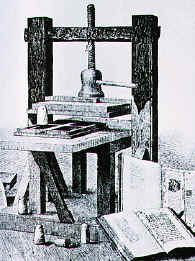25 Jun A World of Chaos
A World of Chaos

We are inundated with information, with virtually no limit on our capacity to produce more. I brought this up in the beginning of the introduction. Since the invention of the printing press a few centuries ago (circa 1447), thinkers and postulators have been able to share information much more effectively (something I am even attempting herein). Today, the 24-hour news cycle creates a strong motivation to produce more content all the time, and the free market drives sensationalism. These two phenomena profoundly diminish the reliability of information by creating the perverse incentive to release information without sufficient analysis or validation.
Besides a flood of information that is often difficult, and sometimes downright impossible, to digest or interpret, we are also enveloped in a flood of new science. A positive result has been that diverse sciences have begun to shape each other through their points of intersection. For example, applied engineering, physics, chemistry, and biology all contributed to the formation of environmental science which has, in turn, benefited its progenitors.
| Understanding Context Cross-Reference |
|---|
| Click on these Links to other posts and glossary/bibliography references |
|
|
|
| Prior Post | Next Post |
| Varieties of Nerve Cells | Gamification – The Future |
| Definitions | References |
| information | Paul DeCelle’s Fractals |
| interpret | Democratzation of Knowledge |
| chaos self-similarity | Another Fractals Post |
With computers, we are learning more about mathematics and physics than ever before. With computer graphics, we can see the splendid beauty of chaos that permeates everything around us. Fractals demonstrate the principles of self-similarity and the symmetries of nature. The mathematics of chaos has shown the validity of many theories that were previously discounted. The simple transformation of a line into an interesting drawing by adding identical triangles shows how the principle of self-similarity can yield interesting results.
Expanding Minds
The arrival of Johann Gutenberg’s printing press brought the expansion of minds that led to the expansion of world exploration. All travel prior to that time was equestrian, pedestrian or marine. The access to information represented by the printing press spawned invention that expanded horizons and opened frontiers. The computer has the potential to contribute as substantially as the press to expanding future horizons!
We know that even in the most convoluted chaos, there is regularity, whether it be linearity, periodicity, self-similarity or some other principle. One substantial value of the computer is its ability to “crunch” long enough to be able to digest enough chaos to ferret out the regularities or patterns. Who knows what we’ll discover as a result?
I have a theory to introduce now and expand upon later: The best way to scale the mountain of information, is to automate its conversion to knowledge. My approach to computerized understanding is very modular, and more granular than anything used widely today. At the core of this approach is Context. Examined closely, context itself is a multi-dimensional universe. Let’s peel back the onion together to find what’s inside.
| Click below to look in each Understanding Context section |
|---|









